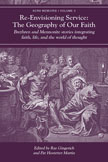| DFD |
||||||
|
|
In the article on “Service” in the Global Anabaptist Mennonite Encyclopedia Online, Peter J. Dyck underlines the twentieth century as a time when service became a word that shaped descendants of the Anabaptists. As Dyck saw it, this usage dates from the 1950 decision of Mennonite Central Committee to add “service” to its tagline task, “relief.” But historian James Juhnke argues that the connection of peace churches’ commitment to service as an idea can be traced back to World War I, when their responses to modern needs to draft soldiers for global war (also called “service”) were challenged and tested. This third volume of The Geography of Our Faith series offers wide-ranging accounts of Mennonite and Church of the Brethren women and men facing the call and challenge of service, shaped by World War II, when service in the form of United States government sanctioned Civilian Public Service (CPS) provided an alternative/mirror opportunity for pacifist men of draft age. Most of the writers in this volume experienced World War II as children or felt its impact on their communities from the adults of the “CPS generation” who raised them or spoke in their churches. New insights emerge from participants here who carried and experienced the evolution of the service vision through and beyond the U.S. war in Vietnam and the Cold War. The inclusion of stories from Church of the Brethren participants provides valuable points of comparison and accounts from parts of the world less familiar to Mennonites. The farm was the first home for most of those who recount their stories here, and if not their own home, a place where they visited with and were nurtured by close family members. Keepers of the service legacy among descendants of the Anabaptist have noted and wondered about the impact of the move within both Mennonite and Church of the Brethren communities away from their rural and farming roots. Clearly, the spirit and flexibility of farm childhoods provided much of the energy for the first forays into service in new and strange environments as these chapters describe. Church life is a given for the storytellers and, for the most part, a comfortable and sustaining foundation for their service. Further, the institutional flowering which occurred in the post-World War II period offered frameworks for expressions of their callings, through agencies such as Mennonite Central Committee, Brethren Volunteer Service, Heifer Project, Church World Service, World Council of Churches, Mennonite Publishing House, and Eastern Mennonite Board of Missions. Interestingly, the anguishing over whether the Anabaptist “theology of service” was adequate to the faith we profess, as expressed in some circles during the twentieth century, seemed not to trouble these storytellers who rather expressed a clear, while not simplistic, confidence in the relationship between their faith and their works. The role played by church colleges in the preparation and orientation to service is a strong interwoven theme among the accounts here. Significantly, the geography of church-related higher education was much broader for Church of the Brethren writers, from the most local, Bridgewater, to the most distant, La Verne (California). For the Mennonite participants, the geography revolves around the tighter educational network of Eastern Mennonite, Hesston, and Goshen Colleges. The learnings of those who have spent a lifetime in service, of course, flow broadly outward from their church college educations. As reflected in these stories, the writers are gentle in character, bearing wisdom that comes from long practice and continuing willingness to humbly engage the questions that emerge over those lifetimes. Among the rich individual vignettes presented here, readers are offered sharp questions and pulled into an ever richer understanding of service. Emmert and Esther Bittinger welcomed a German exchange student into their home, when the wounds of World War II were still raw in the United States, and maintained relationships with her throughout the decades. Kenneth Kreider was confronted by an angry Elizabethtown College student in his history class, labeled a communist, and offered a one-way ticket to Moscow because of his views. Margaret Foth, whose most audible public service was as a radio voice for Mennonite women in transition from homemaking to more professional roles, immersed herself in the diverse faith traditions of international students, finding God in new ways in her retirement years. H. D. Swartzendruber moved from an MCC assignment to work with the World Council of Churches, UNHCR, and the United States Foreign Disaster Assistance Office. Dale Ulrich encountered systemic racism in Baltimore and partnered with the NAACP to publicly protest its presence at a segregated restaurant. Paul Roth pushed through pastoral failure into the work of assisting congregations in the midst of conflict. Bertha Beachy parlayed her bilingual childhood in an Amish family into an ability to enter into Somali culture. Along the way, these humble
servants came to understand and demonstrate that service, for followers
of Christ, is not simple. The lifelong commitments they reflect have
pushed far beyond a straightforward “other side of the coin” of
military service which shaped the churches who first called them. Their
willingness to be stretched, troubled, changed, and renewed along the
way give us hope. Their examples of leaning-in to the needs of the
world inspire us. For that we thank them, and we ask for their blessing
and encouragement for the Anabaptist Christian service callings of the
twenty-first century. |
|||||





